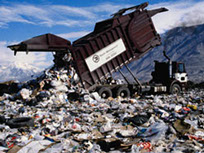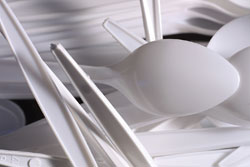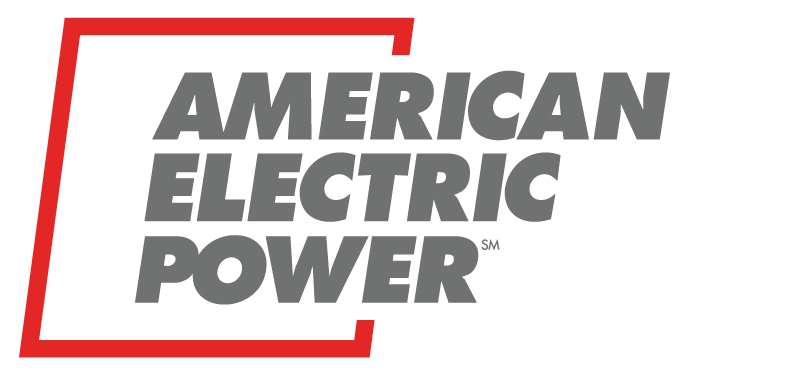
Save Energy to Save the Planet!
The family trash can is a great place to find heaps of wasted energy. Why is that? That’s because most of what is thrown into most people’s trash cans really isn’t trash at all! And what happens later to all that stuff when it is thrown in the trash can anyway? Let’s find out!
Energy All Around
 It takes energy to do just about everything–from heating food on a stove, to powering a car, to powering you! And it takes energy to create the things that we buy including everything from furniture to food.
It takes energy to do just about everything–from heating food on a stove, to powering a car, to powering you! And it takes energy to create the things that we buy including everything from furniture to food.
Where do we get this energy? It can come from fossil fuels such as oil or natural gas, or from water going over a dam or from wind turning a wind turbine or even from sunlight! As energy is consumed to make the things that we use, pollution is created in the form of air or water pollution.
When we buy something, we use it and get rid of the parts that we don’t need–like candy bar wrappers and empty soda cans and used batteries and old busted radios. It took energy to make all those soda cans, and in a way, the energy that created the can is still trapped inside the can. When you finish that soda, you have a choice about what to do with the can. You can throw it away or you can recycle it.
Where does all the garbage go?
 What happens when we throw that soda can away? When you throw something away, it enters what is called the waste stream. Most of what is thrown in the trash can goes straight to the end of the waste steam–a landfill. A landfill is a big place where trash is buried underground. Some trash is incinerated, which means that it is burned.
What happens when we throw that soda can away? When you throw something away, it enters what is called the waste stream. Most of what is thrown in the trash can goes straight to the end of the waste steam–a landfill. A landfill is a big place where trash is buried underground. Some trash is incinerated, which means that it is burned.
Landfills and incineration both have their drawbacks. Landfills often leak, resulting in water pollution. When ground water is polluted, it hurts animals, plants and even pollutes our drinking water. And landfills take up a lot of land. When one is full, another one must be opened. And who wants a landfill in their back yard?!
Incineration creates air pollution because when trash is burned, it can release harmful chemicals into the air.
So, if you throw that soda can in the trash, it contributes to more pollution and more landfills. But we’re also throwing away something else along with the soda can…
 Since it took energy to create everything we’re throwing away, we’re really throwing away energy when we put something in the garbage can.
Since it took energy to create everything we’re throwing away, we’re really throwing away energy when we put something in the garbage can.
When the energy is thrown away, it’s lost forever. If you’re the person who carries out your family’s trash, then you probably know that we throw away a lot of energy!
Can we keep all this energy from being lost forever? Is there a way to save the energy? Can saving this energy help save the planet?
The answer is yes, yes, and yes! By following the 3 Rs, you can save the energy and save the planet.
Reduce~Reuse~Recycle
To make a difference every day, follow the 3 Rs–Reduce, Reuse and Recycle. Following the 3 Rs saves energy, reduces pollution and results in less materials going to landfills.
REDUCE
 The best way to reduce is to avoid wasting materials. Don’t buy things you don’t need or buy more than you will use. If you realize you bought too much of something, share it with your friends so they won’t have to buy as much.
The best way to reduce is to avoid wasting materials. Don’t buy things you don’t need or buy more than you will use. If you realize you bought too much of something, share it with your friends so they won’t have to buy as much.
Another way to reduce is to pay special attention to what you buy. This practice is called “precycling.” To precycle, purchase products that don’t use unnecessary packaging. Snack packs that contain several items (like meat, crackers and cheese) use too much packaging for the small amount of food you receive. You use much less packaging and get much more for your money if you just buy meat, cheese and crackers separately and make your own snack pack each day!
REUSE
 Buy things that can be used over and over again instead of just once or twice.
Buy things that can be used over and over again instead of just once or twice.
Use washable cloth towels instead of disposable paper towels and paper napkins.
Use washable dishes and utensils instead of disposable items.
Reuse shopping bags or buy your own shopping bags. An added benefit is that mesh or nylon shopping bags can hold a lot more than regular plastic shopping bags.
Reuse disposable containers such as milk jugs, drink bottles and plastic storage containers.
Use rechargeable batteries.
Reuse wrapping paper for gifts.
Donate magazines, old clothes or used appliances to schools or libraries or charities that can use the items.
If old clothes are too worn to donate, cut them up and use them as rags.
Pack your sandwich for lunch in a reusable plastic box instead of a baggie.
When something breaks, try to repair it before replacing it.
RECYCLE
 Recycle glass, plastics, aluminum and paper. About half of the materials in landfills are recyclable glass, paper, metal and plastic packaging. Creating recycled materials requires much less energy and produces much less pollution than making new materials. Recycling ensures that used drinking containers don’t end up on the side of the road, polluting a river or overfilling a landfill.
Recycle glass, plastics, aluminum and paper. About half of the materials in landfills are recyclable glass, paper, metal and plastic packaging. Creating recycled materials requires much less energy and produces much less pollution than making new materials. Recycling ensures that used drinking containers don’t end up on the side of the road, polluting a river or overfilling a landfill.
If you want to learn if something is recyclable, just look for the symbol (see picture at right). Notice that the symbol is a never-ending loop.
When you recycle, “you close the loop.” The energy that went into making the soda can is used over and over again when you recycle. If the can doesn’t make it to the recycling center, the energy is wasted and the loop is broken.
Seek out recycling services in your neighborhood. Adjust your shopping habits to recycle as much as you can. If you live in an area that does not accept glass for recycling, try to buy less glass.
Recycling Facts
 Aluminum cans take up to 500 years to break down. The energy saved from recycling one can will run your TV for about three hours. Recycling a soda can saves 95% of the energy to create a new can and produces 95% less air and water pollution.
Aluminum cans take up to 500 years to break down. The energy saved from recycling one can will run your TV for about three hours. Recycling a soda can saves 95% of the energy to create a new can and produces 95% less air and water pollution.
Making a recycled glass bottle requires 50% less energy than making a bottle from new materials and generates 20% less air pollution and 50% less water pollution. Recycling a bottle will save enough energy to burn a light bulb for four hours.
Plastic bottles can be recycled to make all sorts of things including hiking boots, park benches, toys, carpeting and filling for coats and sleeping bags. Less than 10 recycled 2-liter plastic bottles can make enough filling to fill an adult size jacket.
It takes a 15-year-old tree to create half a box of paper. Making recycled paper instead of new paper requires about 60% less energy and water. One ton of recycled paper saves 17 trees and enough oil to drive half-way across the country, enough energy to power a home for six months, enough landfill space to fill a pickup truck, and 60 pounds of air pollutants each year.
With facts like these, it is easy to see why everyone should recycle!
Rethink your family’s habits. Everything that you give to the garbage collector ends up in a landfill. When you go to the trash can, ask yourself if what you’re throwing away is really trash or if there is a better way to dispose of it. Throw away as little as possible by reducing, reusing and recycling. These practices save money, energy and the planet.
Rethink the products your family buys; use things that have less impact on the environment. For example, use biodegradable soaps when possible and only use stronger cleaning agents when soap and water won’t do the trick.
 If something can’t be reused or recycled, do your part to recover it from the waste stream. Take used motor oil to local drop-off centers. If your yard and neighborhood allows, consider composting organic materials such as leaves, grass cuttings and food scraps such as eggshells and coffee grounds. Composting keeps these materials out of landfills where they break down more slowly. Composting also provides you great fertilizer.
If something can’t be reused or recycled, do your part to recover it from the waste stream. Take used motor oil to local drop-off centers. If your yard and neighborhood allows, consider composting organic materials such as leaves, grass cuttings and food scraps such as eggshells and coffee grounds. Composting keeps these materials out of landfills where they break down more slowly. Composting also provides you great fertilizer.
It all comes down to this–the less stuff that ends up in the trash can, the better.
The next time you’re headed to the trash can, stop and ask yourself if something better could be done with the item you’re throwing away. And when you go to the store, stop and think as you’re selecting your items and make smart choices to cut down on materials going to the trash can.
Follow these tips and you’ll save your family money and do your part to save the planet.


 The Environmental Protection Agency reports that 40% of America’s trash is composed of paper products, 17% is yard trimmings, 9% is composed of metals, 8% are plastics, 7% is food scraps, and 7% is glass. Most of the material that ends up being thrown in the trash would be better placed elsewhere.
The Environmental Protection Agency reports that 40% of America’s trash is composed of paper products, 17% is yard trimmings, 9% is composed of metals, 8% are plastics, 7% is food scraps, and 7% is glass. Most of the material that ends up being thrown in the trash would be better placed elsewhere.